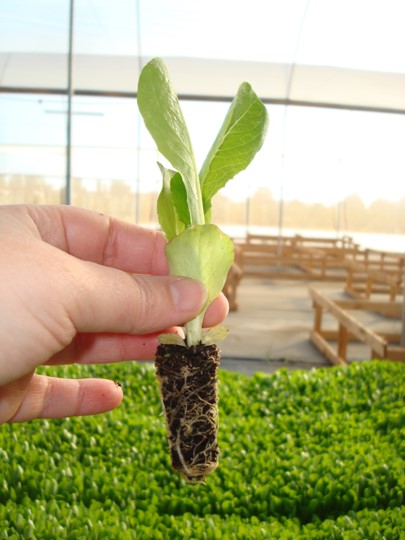Lettuce propagation made easy
Lettuce is one of the most important and widely produced leafy greens in the world. Lettuce can be a challenging crop to successfully produce when you’re not aware of its exact needs. With this article, we aim to bring some knowledge and practical tips to you.
Growing media for lettuce propagation
Just like other crops, lettuce has specific requirements regarding the growing media. In fact, the selection of the right growing media and the correct preparation of play a crucial role in germination.
For the propagation of lettuce, you’re looking for a substrate that enables relative humidity control, while offering enough porosity. This ensures the availability of oxygen to the young plant roots, which is crucial to root and plant development.
In addition, to get the best performance, it’s highly important that the growing media in use match the growing system, irrigation and fertilisation management, and the tray types and size. In lower volume plugs it’s even more vital to choose a type of substrate that matches your practices.
Even sowing depth
To get homogenous germination and growth it’s important to make sure that all seeds are sown in the right depth. The optimal seed depth for lettuce plants is approximately 5mm under the surface.
High sensitivity to environmental conditions
When the seeds are sown in the right growing media and at the desired depth they need the right environmental conditions to germinate and grow strong and healthy young lettuce plants. Let’s have a look at some of the most important conditions.
Temperature
At the start of the lettuce production cycle, you need to germinate your seeds. To get homogenous germination and vigorous growth, It’s best to use a germination room for the first two days after sowing.
A germination room allows you to closely manage the temperature and humidity. This is important in lettuce production. The optimal temperature for germination is between 15 and 18ºC. Deviating temperatures will cause uneven and delayed germination. In the end, this can lead to delayed production and a reduced yield. If the temperatures in the germination environment surpass 30ºC germination will be prevented almost entirely.
When the seeds have germinated, and the young plants have been moved to the nursery the optimal temperature lies at 20-25ºC a little higher than in the germination room.
Moisture
The root system of young lettuce plants is relatively sensitive to changes in moisture content. Even more so than other plants like tomatoes. If the growing media supporting the plant roots stays too wet over time, roots can get damaged, and growth can get stunted. That’s why you should take great care to avoid excessive irrigation.
A lack of irrigation, and consequently a rooting environment that gets too dry, prevents roots from taking up nutrients and will also harm the crop.
It all comes down to using the right irrigation system that distributes the water in a uniform way, the amount of water used for every irrigation, and the frequency and timing of the irrigations.
So, closely managing your moisture levels is highly important in lettuce propagation.

Transplanting
The duration of the seedling cycle can vary from 25 to 50 days. The exact duration of the lettuce production cycle depends on your location, the time of year, and the characteristics of your greenhouse.
The transplanting of the lettuce plants can be done as soon as the plants are approximately 8cm tall and have 5-6 leaves each.
You’ll be able to get the most out of your lettuce plants and consequently optimise your yield by following these guidelines!

